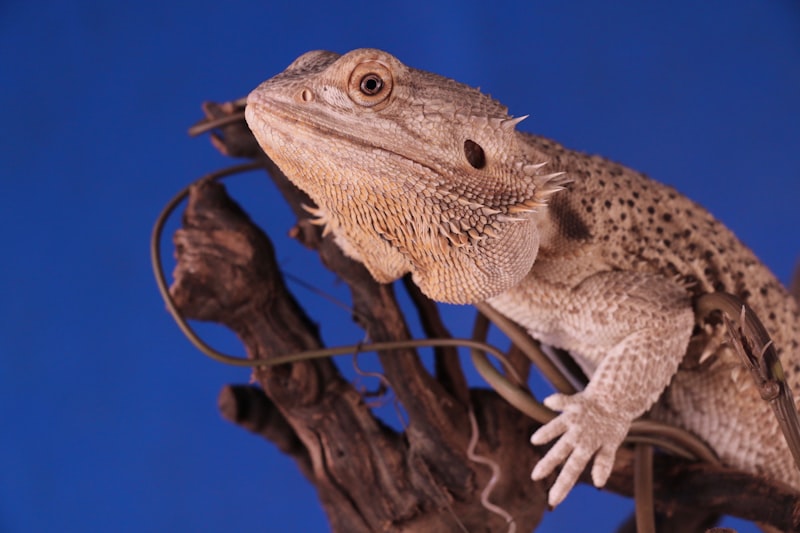Have you ever wondered about the incredible diversity of reptiles out there? Some of these creatures have truly bizarre adaptations that help them survive in their unique environments. From the depths of the rainforests to the arid deserts, these strange and rare reptile species have evolved fascinating traits over millions of years.
Let’s start with the Satanic Leaf-Tailed Gecko, a master of camouflage found in Madagascar. This reptile doesn’t just blend in with its surroundings; it mimics a dead leaf with remarkable accuracy. Its body resembles a dried leaf right down to the veins and discoloration, making it nearly invisible to predators and unsuspecting prey alike.

Moving on to the Gharial, an aquatic reptile native to the rivers of the Indian subcontinent. What sets this species apart is its long, slender snout adorned with numerous sharp teeth. This adaptation is perfect for catching fish, its primary food source. The Gharial’s distinct appearance is a result of millions of years of evolution, finely tuned to its riverine habitat.
Ever heard of the Mata Mata Turtle? Found in the murky waters of the Amazon and Orinoco basins, this reptile looks like a piece of drifting bark or debris. Its flattened head and neck are covered in tubercles and flaps of skin that resemble algae-covered bark, allowing it to ambush fish and small prey with ease.
Lastly, consider the Thorny Devil, a lizard native to Australia. This small creature has a spiny exterior that serves multiple purposes. Not only does it deter predators, but the channels between its spines collect water from its skin, a vital adaptation in the arid Australian outback.
These strange and rare reptile species showcase the astonishing diversity and adaptability of life on Earth. Each one has evolved unique traits that help it thrive in its specific niche, proving once again that nature is full of surprises.
The World’s Rarest Reptiles: Unveiling Nature’s Hidden Gems
Take, for instance, the Tuatara (Sphenodon punctatus) of New Zealand, often dubbed a “living fossil.” This ancient reptile has remained virtually unchanged for over 200 million years, surviving even the extinction of its dinosaur contemporaries. With its distinctive third eye on the top of its head and a lifespan that can exceed a century, the Tuatara symbolizes resilience and evolutionary endurance.
Moving across the globe to the Caribbean, we encounter the Cuban Crocodile (Crocodylus rhombifer). Endemic to Cuba, this species represents a fascinating case of adaptation to its environment. Known for its striking greenish coloration and slender build, the Cuban Crocodile inhabits freshwater swamps and rivers, where it plays a crucial ecological role as a top predator.
Venturing into the depths of Madagascar’s rainforests unveils the Satanic Leaf-Tailed Gecko (Uroplatus phantasticus). Aptly named for its leaf-like appearance and devilish camouflage, this gecko masters the art of disguise, blending seamlessly into its leafy surroundings. With its flattened body and tail that resembles a decaying leaf, the Satanic Leaf-Tailed Gecko remains an enigmatic marvel of natural selection.
Closer to home, the Jamaican Boa (Chilabothrus subflavus) inhabits the rugged limestone forests of Jamaica. As one of the largest snakes in the Caribbean, this boa thrives in the island’s unique ecosystem, preying on birds and small mammals. Its golden-yellow coloration and docile nature make it a sought-after subject for both conservationists and herpetologists.
Beyond the Ordinary: Reptiles With Bizarre Survival Strategies
Take the axolotl, for instance. Often referred to as the “Mexican walking fish,” this amphibious creature has an astonishing ability to regenerate its limbs. It can regrow not just legs but also parts of its brain and spinal cord. Imagine if humans could regrow a lost limb like that! The axolotl’s unique regenerative powers have fascinated scientists for decades, offering hope for medical advancements in tissue regeneration.
Moving on to the frilled-neck lizard, found in northern Australia and New Guinea. When threatened, this lizard unfurls a remarkable frill around its neck, making itself appear larger and more intimidating to potential predators. It’s like having a built-in scare tactic that helps it evade danger without having to engage in a physical altercation.
Let’s not forget the tuatara, native to New Zealand. Despite resembling a lizard, the tuatara is actually a distinct reptile with unique characteristics. One of its standout features is a “third eye” located on the top of its head. While this eye isn’t used for vision in the conventional sense, it helps regulate its circadian rhythms, allowing it to be more in tune with its environment. It’s akin to having a natural clock that helps it stay active during the right times of day.
Another marvel of adaptation is the horned lizard of North America. When threatened by predators, this lizard can shoot a stream of blood from its eyes as a deterrent. This surprising defense mechanism not only startles attackers but also tastes foul to canines and felines, making them think twice before trying to make a meal out of it.
Lastly, consider the flap-necked chameleon, known for its ability to change color to blend into its surroundings. This isn’t just for camouflage but also serves as a means of communication and regulating body temperature. It’s like wearing a mood ring that reflects both emotions and environmental conditions.
These reptiles prove that nature has equipped them with astonishing abilities to survive and thrive in their respective habitats. Each species showcases unique adaptations that continue to captivate researchers and enthusiasts alike, shedding light on the diversity and resilience of the animal kingdom.
Incredible Adaptations: How Strange Reptiles Thrive in Extreme Environments
Take, for instance, the horned lizard, a desert dweller known for its ability to survive in arid landscapes where temperatures soar. This lizard’s unique defense mechanism involves shooting blood from its eyes when threatened, deterring predators effectively. Its skin texture and coloration blend seamlessly with the desert terrain, offering camouflage against potential threats.
On the opposite end of the spectrum lies the wood frog, found in colder climates where freezing temperatures pose a constant challenge. This amphibian has developed a fascinating adaptation: the ability to freeze solid during winter hibernation, only to thaw and resume normal function as temperatures rise in spring. This survival tactic involves producing a special type of antifreeze that prevents ice crystals from forming within its cells, ensuring vital organs remain undamaged.
These adaptations not only ensure survival but also inspire awe at the resilience and ingenuity of these creatures. By understanding how reptiles like the horned lizard and amphibians like the wood frog adapt to extreme environments, scientists gain valuable insights into evolutionary biology and the potential impacts of climate change on wildlife.
The adaptations of strange reptiles and amphibians serve as poignant reminders of nature’s ability to innovate and overcome adversity. As we continue to study and protect these incredible species, we unlock more of nature’s secrets and pave the way for a deeper appreciation of our planet’s biodiversity.
Meet the Unseen: Rare Reptiles With Unusual Physical Traits
Ever wondered about the hidden marvels of the reptilian world? Meet the unseen champions—rare reptiles with extraordinary physical traits that defy expectations and captivate the imagination.
In the realm of reptiles, uniqueness reigns supreme. Take for instance, the Satanic Leaf-Tailed Gecko, a master of disguise with skin that mimics dead leaves, blending seamlessly into its forest habitat. This remarkable creature not only evades predators but also astounds researchers with its camouflage prowess.
Moving to the depths of the ocean, we encounter the Goblin Shark—a creature straight out of a deep-sea nightmare. Its elongated, blade-like snout and jaw that protrudes like a spear are adaptations evolved over millennia to snatch prey swiftly and efficiently in the darkness of the deep.
For those fascinated by the ancient and armored, the Gharial stands as a testament to time. This endangered crocodilian species sports an incredibly long, slender snout resembling a potter’s trowel, perfectly adapted for swift underwater movement and snagging fish.
In the world of snakes, the Horned Viper commands attention with its striking horn-like scales above each eye. These horns are not for gore but serve as a defense mechanism and aid in camouflage, allowing the snake to ambush unsuspecting prey in arid landscapes.
From the jungles of Madagascar emerges the Panther Chameleon, a reptilian marvel known for its vivid colors and independently rotating eyes—a trait that gives it a 360-degree field of vision, essential for spotting predators and prey alike.

These examples highlight just a fraction of the diversity and ingenuity found in the world of rare reptiles. Each species tells a story of adaptation and survival, showcasing nature’s endless creativity and resilience in the face of challenges.
Explore further into this hidden world, and you’ll discover even more extraordinary creatures with unusual physical traits, each contributing to the rich tapestry of life on Earth.
Frequently Asked Questions
What are the most intriguing evolutionary traits seen in strange reptile species?
Explore fascinating evolutionary traits found in unusual reptile species, such as bioluminescence in deep-sea creatures, camouflage abilities that mimic surroundings, thermal sensing organs for hunting in darkness, and unique reproductive strategies like parthenogenesis.
How do reptiles develop unique adaptations to their environments?
Reptiles develop unique adaptations to their environments through evolutionary processes that enhance their survival. These adaptations include specialized skin for temperature regulation, unique limb structures for movement, and behaviors tailored to their habitats. Over time, these traits help reptiles efficiently navigate their specific environments, ensuring their continued existence and reproductive success.
What are some examples of strange reptile species with unique adaptations?
Explore fascinating reptile species with unique adaptations, such as the Satanic leaf-tailed gecko, which camouflages with its environment, and the flying dragon, capable of gliding through the air with wing-like flaps of skin. Discover how the spiny-tailed iguana survives in extreme desert conditions, and learn about the bizarre matamata turtle, known for its leaf-shaped head and vacuum-like feeding mechanism.
Why are rare reptile species often associated with unique adaptations?
Learn why rare reptile species often possess unique adaptations in their environments. Understand how evolutionary pressures drive these adaptations to enhance survival and ecological niche specialization.
How do researchers study the adaptations of rare reptile species in the wild?
Researchers study the adaptations of rare reptile species in the wild through a combination of field observations, ecological surveys, and genetic analyses. They observe behaviors, habitat preferences, and interactions with other species to understand how these reptiles survive and reproduce in their environments. Genetic studies help reveal evolutionary changes that contribute to their adaptation over time.


